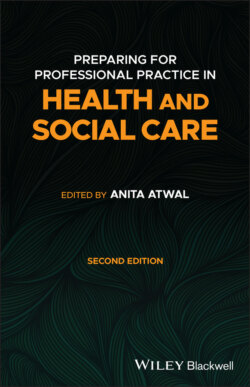Preparing for Professional Practice in Health and Social Care

Реклама. ООО «ЛитРес», ИНН: 7719571260.
Оглавление
Группа авторов. Preparing for Professional Practice in Health and Social Care
Preparing for Professional Practice in Health and Social Care
Contents
Guide
Pages
Contributors List
Introduction
Preparing for Allied Health Professional Practice in Health and Social Care
References
Chapter 1 Reflection The Link between Professionalism, Evidence-Based Practice, and Clinical Reasoning
Chapter Overview
Professionalism
Knowledge
Conceptions of Practice
Evidence-Based Practice
Clinical Reasoning
Reflection in Practice
Critical Thinking Is Not Possible without Reflection
Reflection and Reflexivity
Case Study 1 – Interprofessional Collaboration: Differing Assumptions Informing Ideas
Reflection Is Not Only an Individual Act
Reflective Models, Settings, and Tools
Models of Reflection
Case Study 2 – Individual Reflection (Model of Reflection): Realisation that Not as Evidence Based in Practice as First Thought
Case Study 3 – Individual Method of Reflection (Post-Graduate Study): Didn’t Find What Was Expected but Found More
Service User Perspective and Reflection – Shani Shamah
Key Take Home Messages
References
Chapter 2 Care and Self-Care
Chapter Overview
What Is Care?
The Science of Care
Why Self-care Is Important
Stress and Burnout
Methods of Self-Care
Boundaries
Resilience
Reflective Practice and Schwartz Rounds
Chaplaincy Services
Organisational Culture
Service User Perspective: Shani Shamah
Summary
Key Take Home Messages
References
Chapter 3 Ethics and Professional Practice
Chapter Overview
Personal and Professional Values
Unethical Behaviour
Fitness to Practice
Standards of Conduct, Performance, and Ethics
Standards of Proficiency for Physiotherapists
Questions to Consider
Ethical Theories
Utilitarianism
Scope of Practice
Deontology
Whistleblowing
Virtue Ethics
The Virtue of Trustworthiness
The Principle-Based Approach
Respect for Autonomy
Autonomy Reflection
Non-maleficence
Non-Maleficence Reflection
Beneficence
Justice
Justice Reflection
Social Justice
Reflecting on the Four Principles
Moral Dilemma: Case Study
Autonomy
Non-Maleficence
Beneficence
Justice
Summary
Ethical Disagreement
The Second Victim Phenomenon
Moral Distress
Disruptive and Uncivil Behaviour
Summary
Key Take Home Messages
References
Chapter 4 Culture and Allied Health Professions Service Delivery
Chapter Overview
Background. Culture and Professional Practice
Sociocultural Perspective of the AHPs
Belonging in AHPs
Power Dynamics and Equalising Space
Why Do You Need to Know about Culture as AHPs?
Race, Equality, Diversity, and Inclusion-Relevant Legislation for Service Delivery
How do AHPs improve their ability to attend to cultural aspects of person-centred care? A checklist to take action to change
Checklist for Action – What to Do
Key Take Home Messages For You
Critical Questions
References
Chapter 5 Quality Assurance, Quality Improvement, and Leadership
Chapter Overview
Leadership
Box 5.1 Some questions to reflect on in relation to leadership
Box 5.2 Leadership styles
Quality Assurance and Change Management Models
Box 5.3 #EndPJParalysis campaign (Dolan and Holt Consultancy 2021)
Box 5.4 Quality assurance models (NHS England and NHS Improvement 2021; NHS Improvement 2011)
Implementing Change
Service User Voice in Quality Improvement
Stage One: Making the Case for the Project
Stage Two: Building the Team
Stage Three: Observation
Stage Four: Recruitment of Professionals and Service Users
Stage Five: Co-Designed Groups
Box 5.5 Service user’s top tips on co production
Stage Six: Communicating Outcomes
Audit
Box 5.6 Clinical audit process
Box 5.7 Audit case study (Chelsea and Westminster Hospital NHS Foundation Trust 2019, p. 19)
Key Take Home Messages
References
Chapter 6 Allied Health Professionals and Interprofessional Practice
Summary
Box 6.1 Interprofessional collaboration definition
Teams
Box 6.2 Serious case review case study
Be Able to Communicate and Have a Strong Professional Identity
Documentation and Communication
Box 6.3 The eight Caldicott principles (UK Gov. 2020)
Box 6.4 Fitness to practice case
Box 6.5 Standards for note writing
Electronic Care Records
Box 6.6 Examples of dehumanising language to be avoided
Understand and Have Knowledge about the Role of Other Professionals and Support Staff
Know How to Manage Differences
Box 6.7 Balint groups to manage difference in teams (Based onSalinsky 2009)
Show Leadership When Needed
Box 6.8 Patient leaders
Key Take Home Messages from Shani Shamah (Expert by Experience)
References
Chapter 7 Preparing for Successful Career Transitions
Chapter Overview
Preparation for Transitioning
The Application Form
Box 7.1 Which first post?
How Do I Make My Application Stand out?
Box 7.2 Important point to cover in the application process
The Application Process. Preparation for the Interview
Box 7.3 Values of the NHS (Health Education England 2021)
Box 7.4 Some commonly asked interview questions
Try to Avoid These Common Pitfalls
Preceptorship, Mentorship, and CPD
Box 7.5 Definition of preceptorship
Mentorship
Box 7.6 Skills of a mentor – What to look for (Based on Phillips-Jones 2003)
Continuing Professional Development (CPD)
Box 7.7 How to negotiate time or funding for CPD
Key Take Home Messages
References
Chapter 8 Professional Identity and Allied Health Professional Practice
Chapter Overview
Professional Identity
Box 8.1 Top Tips on Professional Use of Social Media Based on HCPC Guidance (2021)
Box 8.2 Do these factors matter in promoting professionalism?
Box 8.3 Key characteristics of effective supervision based on a systematic review of available literature (Rothwell et al. 2019)
Box 8.4 Principles of Authentic Allyship (Coghill 2020)
What is Professionalism within the Context of Allied Health?
Top Tips from Rachel Moses on Twitter (@AHPLeader) Include
Box 8.5 Rational Decision-Making: Unpicking a well-known quote
Key Take Home Messages
References
Index
WILEY END USER LICENSE AGREEMENT
Отрывок из книги
Second Edition
Edited by
.....
These three types of knowledge are all distinct and require skill and thought in order to embed within practitioners or students. Reflection and reflexivity are important ways to not only understand and ‘own’ knowledge for practice but also to improve and, even more crucially identify, ineffective practice.
We have defined professionalism and discussed a wider definition of knowledge. Common methods of applying that knowledge into professional practice – EBP and clinical reasoning – have been discussed. It has been suggested that reflection and reflexivity are important methods to uncover the complex knowledge used in practice. The following section examines reflection and gives case studies to help the reader deepen their understanding.
.....